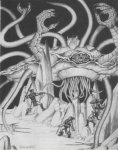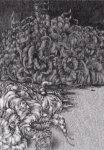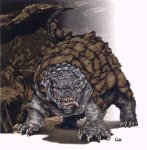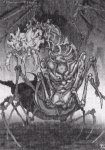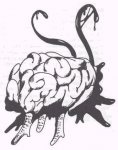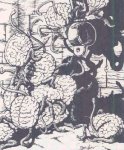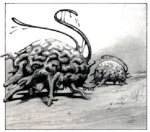Draknor
Draknor
Gargantuan Aberration (Extraplanar, Fire)
Hit Dice: 22d8+110 (209 hp)
Initiative: +0
Speed: 0 ft.
Armor Class: 27 (-4 size, +21 natural), touch 6, flat-footed 27
Base Attack/Grapple: +15/+39
Attack: Claw +24 melee (3d6+12/19-20) or tentacle +23 melee (2d4+6) or heat ray +12 ranged touch (5d12 fire)
Full Attack: 2 claws +24 melee (3d6+12/19-20) and 4 tentacles +21 melee (2d4+6) or heat ray +12 ranged touch (5d12 fire)
Space/Reach: 20 ft./20 ft. (60 ft. with tentacles)
Special Attacks: Constrict 2d4+18, earthquake strike, heat ray, improved grab, swallow whole
Special Qualities: Damage reduction 5/epic, darkvision 60 ft., healing flames, immoveable, immune to mind-affecting effects, immunity to fire, electricity, and poison, reflect mind blast, resistance to acid 20, spell resistance 30, tendrils, tremorsense 120 ft., vulnerability to cold
Saves: Fort +14, Ref +7, Will +16
Abilities: Str 35, Dex 10, Con 21, Int 14, Wis 16, Cha 12
Skills: Diplomacy +3, Knowledge (dungeoneering) +22, Knowledge (the planes) +22, Listen +18, Search +22, Sense Motive +13, Spot +18, Survival +3 (+5 on other planes, +5 underground, +5 following tracks)
Feats: Awesome Blow, Great Fortitude, Improved Bull Rush, Improved Critical (claw), Multiattack, Power Attack, Weapon Focus (claw), Weapon Focus (heat ray)
Environment: Elemental Plane of Earth or Elemental Plane of Fire
Organization: Solitary
Challenge Rating: 18
Treasure: None
Alignment: Always neutral
Advancement: 23-32 HD (Gargantuan)
Level Adjustment: —
This creature stands over two stories tall, tethered to the cavern walls by a dozen long, rocklike appendages. Its wide clamlike body consists of two shells, with dozens of eyestalks and other sensory organs peering through the gap between these shells. A pair of reptilian claws protrudes from its front, and four large dorsal tentacles stretch out from its back. Several dozen tendrils trail beneath, each seemingly endlessly long.
The draknor is the larval form of an extraplanar monstrosity of unbelievable power. For reasons that remain an enigma, draknor eggs are deposited on the Material Plane, deep underground in secluded caverns near sources of great heat. When these eggs have incubated for a year, the larval draknor hatches and feeds on the heat until it reaches maturity, when it migrates back to the elemental planes. Adult draknors are never encountered on the Material plane, and no encounter with one on the elemental planes has yet been documented.
While it subsists solely on heat, a draknor can consume and digest nearly anything. Along with its preferred habitat, this makes it a particular threat to illithids and other Underdark races. The draknor's immunities render illithids nearly powerless against them.
Although draknor are highly intelligent, their thought processes are totally alien. They cannot (or choose not to) communicate with other creatures.
A larval draknor is 55 feet wide, 40 feet long, and about 25 feet high, and weighs 100 tons.
Combat
Though still larval on the Material Plane, a draknor is a behemoth and a terror in combat. Draknors are usually hunted down and destroyed when their presence is discovered. A draknor is intelligent enough to coordinate its many attacks between several different foes, and uses its tendrils to cause an earthquake before any creatures get anywhere near its lair.
An opponent can attack a draknor’s tentacles with a sunder attempt as if they were weapons. A draknor’s tentacles have 30 hit points each. If a draknor is currently grappling a target with the tentacle that is being attacked, it usually uses another limb to make its attack of opportunity against the opponent making the sunder attempt. Severing one of a draknor’s tentacles deals 15 points of damage to the creature. The creature regrows severed limbs in 1d6 days.
A draknor’s natural weapons, as well as any weapons it wields, are treated as epic weapons for the purpose of overcoming damage reduction.
Constrict (Ex): A draknor deals automatic tentacle damage with a successful grapple check.
Earthquake Strike (Ex): A draknor can cause a minor, localized earthquake from the end of any of its tendrils as a standard action, once per round. This affects all creatures in a 30-foot radius directly above the tendril, on the ground level. Targets will be knocked prone if not secured, and must succeed on a DC 26 Fortitude save or be stunned for 1d4+1 rounds. The save DC is Constitution-based.
Heat Ray (Ex): A draknor may spew the heat that it channels through its tendrils into a ruby-red ray. This ray comes from its mouth, and has a maximum range of 200 feet with no range increments. A draknor cannot be struck with its own heat ray.
Improved Grab (Ex): To use this ability, a draknor must hit with a claw or tentacle attack. It can then attempt to start a grapple as a free action without provoking an attack of opportunity. If it wins the grapple check, it establishes a hold and can constrict if grappling with a tentacle. If grappling with either a claw or tentacle, the draknor can transfer the opponent to its mouth and attempt to swallow the foe in the following round.
Swallow Whole (Ex): A draknor can try to swallow a grabbed opponent of Huge or smaller size by making a successful grapple check. The swallowed creature takes 4d6+6 points of crushing damage plus 4d8 points of acid damage and 4d8 points of fire damage per round from the draknor’s gizzard. A swallowed creature can cut its way out by using a light slashing or piercing weapon to deal 50 points of damage to the draknor’s gut (AC 20). Once the creature exits, muscular action closes the hole; another swallowed opponent must cut its own way out.
Healing Flames (Su): Any attack that deals fire damage heals a draknor for 1 point of damage for each point of damage the attack would otherwise deal. A draknor cannot exceed its full normal hit points as a result of this healing. A draknor gets no saving throw against fire effects.
Immoveable (Ex): A draknor anchors itself to the walls of its lair using 12 rock-hard extensions. This renders a draknor immune to bull rush and trip attacks.
Reflect Mind Blast (Su): If a draknor is hit by a mind blast ability, it can turn the mind blast back upon the creature attacking it. Instead of a 60-foot cone, this attack manifests as a focused beam that strikes only the creature that attacked with the mind blast. The DC is the same as that of the creature that attacked with the mind blast.
Tendrils (Ex): A draknor has 30 tendrils that it uses to feed on heat sources. These snaky tendrils move independently of the draknor’s body, at a speed of 40 feet per round, and burrow through solid rock at a speed of 30 feet per round. The ends of these tendrils can reach up to a mile away from the draknor’s main body. If one or more of a draknor’s tendrils taps into a source of continual heat (such as magma), the draknor heals 3 points of damage per round (as fast healing). A draknor does not benefit from its fast healing in any round in which it uses its heat ray.
An opponent can attack a draknor’s tendrils with a sunder attempt as if they were weapons. A draknor’s tendrils have 10 hit points each. Severing one of a draknor’s tendrils deals 5 points of damage to the creature. If 10 or more tentacles are severed, its fast healing is reduced to 2 points per round, and if 20 or more are severed, it is reduced to 1 point per round. These tendrils do not regrow without magical healing, and if all are severed, the draknor dies of starvation in two weeks.
 this thread will be like the ones in the homebrews forum, and will serve the purpose of hosting the writeups for the creatures we will be using in the article we send to Dragon. each of these creatures has its own thread in this forum, which is the proper place to discuss the monster.
this thread will be like the ones in the homebrews forum, and will serve the purpose of hosting the writeups for the creatures we will be using in the article we send to Dragon. each of these creatures has its own thread in this forum, which is the proper place to discuss the monster.

